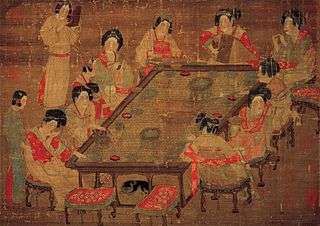Ruqun

Ruqun (襦裙) is an item of traditional Chinese attire (Hanfu) primarily for women but also for men. It consists of a blouse (襦, ru) and a wrap-around skirt (裙, qun; also called 裳, chang). It is the eldest type of hanfu which is said to have been worn by the legendary Yellow Emperor[1] and it is said to be worn by women since the Warring States period.
History
Ruqun is the most basic type of Hanfu. It is said to be the basic clothing up to the 3 Sovereigns and 5 Emperors age. At that time, it was worn by both men and women.
Generally, the blouse was tucked into the skirt. The popularity of ruqun declined during the Han Dynasty. Although the popularity of women wearing ruqun increased again during the Southern and Northern Dynasties, most of men did not wear it any more. In the Wei Dynasty and Jin Dynasty ruqun went through a major change when women started to wear much longer upper garments which needed to be put out of the skirt.[2] This new style of ruqun was called shanqun (衫裙) and existed with ruqun. During the Sui and Tang Dynasty, the skirts were tied higher and higher up the waist, until they were eventually tied above the breasts, worn with short blouses. In addition to the normal crossed-collar blouses, parallel/straight-collar (對襟) blouses were also worn in this period, thus exposing the cleavage of the breasts. During the Song Dynasty, the skirts were eventually lowered from the breast level back to the normal waistline. In the early Ming Dynasty, ruqun's variant, shanqun, went through a major change when women stopped using the sash. This new style of ruqun, also called aoqun (襖裙), became popular in the late Ming Dynasty.[3]
Late Imperial Era
By the Ming Dynasty, ruqun became the most common form of attire for women. The sleeves of the blouse are mostly curved with a narrow sleeve cuff (琵琶袖, pipa sleeve). The collar is of the same colour as the clothing. Often, there is an optional detachable protective huling (護領, lit. "protect collar") sewn to the collar. The huling can be white or any dark colour, and is used to protect the collar from being rotten by sweat, therefore to extend the life of the clothing. Towards the start of the Qing Dynasty, the skirt was mostly baizhequn (百摺裙, lit. "hundred pleats skirt") or mamianqun (馬面裙, lit. "horse face skirt").[3]
-

A Han Dynasty painting illustrates women wearing ruqun, with blouses tucked into skirts
-
_by_Emperor_Huizong.jpg)
A Tang Dynasty painting illustrates women wearing ruqun, with skirts tied above the breasts and short parallel-collar blouses
-

Another Tang Dynasty painting illustrating ruqun
-

A Tang Dynasty palace concert wearing ruqun
-

A painting by Ming Dynasty painter Tang Yin illustrating women in ruqun
-

A painting by Ming Dynasty painter Tang Yin illustrating women in ruqun
-

A painting by Ming Dynasty painter Tang Yin illustrating women in ruqun
-

Illustration of Ming Dynasty ruqun
-

Illustration of Ruqun and Pifeng during Qing Dynasty[1]
- ^ Antonia Finnane (2007), Changing clothes in China, Columbia University Press, p. 359
See also
- Xuanduan (玄端): a very formal dark ruqun with accessories; equivalent to the Western white tie
- Han Chinese clothing
- List of Han Chinese clothing
Notes and references
| ||||||||||||||||||